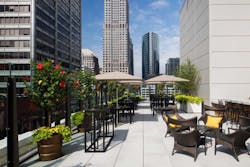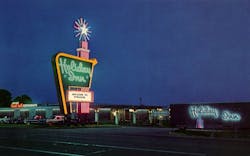15 ways 'soft brand' hotel chains can distinguish themselves
Hospitality’s dynamism and its current reinvention is most visible in today’s "soft brands"—chain hotels that rely on their own individual identity instead of an organization's. Hospitality’s biggest names are creating new, evolved boutique brands to appeal to the tastes and lifestyles of today’s traveler. These soft brands are evolving to compete in the landscape of boutique hotels and Airbnb.
1. Experiences
Today’s generation of travelers is increasingly interested in experiences. Usually this means smaller scale experiences within the community they’re visiting. To attract this type of traveler, new brands and hotels must come up with new combinations of programming to differentiate themselves from traditional hotels.
2. Rooftops trump ballrooms
Take the Hyatt brand, for example. Typically, the Hyatt Regency is associated with a large ballroom and meeting space. The push now with the Hyatt Centric brand is to create something more experiential. In Chicago, they took a 22-story Art Deco bank building designed in 1927 and adapted it, kept the bones of a historic building, put a great signature celebrity food and beverage outlet (Cochon Volant Bakery, Brasserie and Bar) on the first floor and designed a rooftop destination with spectacular views.
3. Eat and drink to the beat
The Virgin Hotels brand is another great example. Typically the traditional hotel model features one food and beverage, three-meal restaurant within the hotel. Guests dine there for breakfast, lunch and dinner. The new trend in hospitality, not only in boutiques but also in branded hotels, is to offer a variety of food and beverage outlets. The guest is not going to visit the same restaurant or experience the same restaurant each and every time they have a meal within the hotel. You can have sushi at one restaurant, you can go to a steak house, a hip version of a diner, perhaps a Mexican or Greek or theme-type restaurant as well. Guests have choices.
4. Regional flavor
Even the hotel café will have some regional flavor. The boutique brand will partner with a local roaster or host a local coffee chain. Bow Truss, for example, was selected by Virgin to service their café in Chicago. They went and tried out all the local roasters and coffee shops and chose the Bow Truss brand. It’s increasingly popular for brands to do that now—rather than offering coffee from a national chain—they’ll opt to serve something local. They’re working with farm-to-table concepts, showing that their chef buys the produce from local markets.
5. Technology is cutting edge
Technology is a huge element, here. If you fly Virgin America from New York City to LA or to Chicago, if you’re on Virgin America and you’re watching a movie on the airplane and it lands before it’s finished, you save it, and when you get into your room, you can finish watching it on the screen. That’s the kind of experience the new technology allows for in terms of hospitality.
6. Mobile room key
You walk in the hotel, check-in with your phone, you scan it at your door, and you’re in your room. You don’t have to speak to anyone at a check-in desk, you just go straight to your room. Check-in is seamless.
7. A living room experience
The big push is for living room experience, and you’ll see that now in a lot of the new hotels. You get the feel of the living room when you walk in, so a communal area where the restaurant is there but it’s very small and boutiquey, like a large dining room within a large home. There are lounge areas around the dining experience, the bar is more open and more user-friendly. It’s set up so you can pour your own wine. It’s a more of a living room with a communal feel versus the old days where you check in and there’s a barrier, more like a teller at a bank, between you and the check-in agent.
8. Pop-up culture
These hotels will become venues. At small pop-up venues they can book local bands and host art galleries, receptions and feature local artists. It’s all about becoming local and involving the community and culture from the area. The idea of the hotel being only for the hotel guest is going away as well. Rather, it’s a place where people can meet, enjoy cocktails on the rooftop and listen to a band perform. It’s a cultural destination.
9. Holiday Inns
Miami might be where the boutique craze started. But this idea of hotels as cultural venues actually goes back to what Holiday Inns and Sheratons used to be in the fifties and sixties. People would visit these hot spots on Friday or Saturday nights to hang out, you always had a house band playing, or people would rent out the ballrooms and hold functions with local entertainment. The Holiday Inn in most small towns was the place to go on Friday and Saturday nights—that’s where the local and regional bands played live.
10. Reservation systems
These soft brands have a big advantage in that guests can still get into a reservation system and earn their rewards points. Traditionally, a one-off boutique hotel doesn’t belong to any reservation system where one can access rewards points. Now they’re allowing boutiques to become part of their brand through “collections,” with names such as Autograph, for example.
11. With brand reliability and service
The soft brands have a good reason to remind guests of their brand connection. They want guests to know that they have a reputable brand standing behind their stay. So if you have an issue with your travel, you’re calling Hyatt, you’re calling Hilton, you’re calling Marriott. You’re calling the reservation and you’re getting the big corporate backing behind your travel because for most people, it’s very expensive and you’re spending a lot of money. These hotels aren’t cheap; they’re 200 to 500 dollars a night for many boutique hotels so travelers still want that big, corporate umbrella to protect their travel and give them the insurance so that if there’s any issue, they’ll take care of it. A big differentiator is that the training and customer service is at a level you expect from a big reputable brand.
12. Less clubby, less intimidating
It turns out that a club atmosphere is intimidating for a lot of people. It was really hip and cool for about seven years. Trends change. We’re seeing boutiques getting away from the club trend and moving toward a culturally cool experience.
13. Neighborhood influence
Within large cities like New York and Chicago, the culture and community changes depending on where the hotel is located, be it Soho, the Meatpacking District, Upper East Side to Brooklyn. So they can have a boutique brand hotel in each one of those that feel very different. Wherever you go and stay, it’s going to feel like you belong in and are actually part of the neighborhood.
14. Customizing experiences
The key is customizing the experience within the culture of the community. And again, one of the biggest hot points is allowing the community to invite themselves into the hotel, hence the living room feel which doesn’t require a room key. With a living room experience, you can go in, sit down, and have a glass of wine or coffee from a local roaster. You’re willing to walk six blocks to get your coffee because they’ve sourced coffee locally. Locals can say “let’s meet at the hotel, we can have our business meeting in the lounge, we can get a coffee or cocktail.” It draws them in, increases the food and beverage sales so it gives the hotel a better return on investment and activates the lobby at different times of the day so when visitors walk in, it’s not a dead zone. There are a lot of pluses to it.
15. Sized to go
It used to be that guests would check into a hotel and it had to be very large and functional for a number of reasons. Today, millennials and people who want experiential travel go to a hotel just to sleep and take a shower. From the minute they wake up, they’re out the door and experiencing what the city or the destination has to offer, wherever they are. So the idea of sitting in your hotel and making a plan for something or with a concierge? No, they’re not interested. These people are out and about. The Internet has changed travel planning. They’ve already researched the area and they know what they want to do, and so that has changed a lot about hotels. The size of the room comes down and that increases the key count and allows for more food and beverage, as well as these venues. So it gives you the ability to do three or four restaurants in a hotel and still maintain the key count within the programmed square footage of the building. It’s an exciting, challenging and transformational time in hospitality.
About the Author: Mark has more than 25 years experience with significant projects ranging across Hospitality, Healthcare and Commercial + Mixed Use markets. His management of multi-disciplined project teams in the planning process has helped VOA secure its reputation for shared project authorship and a legacy of on-time, on-budget project delivery. He currently focuses his time and efforts on building our portfolio in South America and the Caribbean.
About the Author
Stantec
Published by global design firm Stantec, this eclectic blog features viewpoints, insights, and explanations from Stantec architects, engineers, and designers, on a range of issues impacting the fabric of our communities. Our contributors share their thoughts about design trends, emerging technologies, vexing challenges, and inspired solutions. For more blog posts, visit our Ideas page. Follow us on Facebook, Instagram, LinkedIn, and Twitter, and YouTube.

